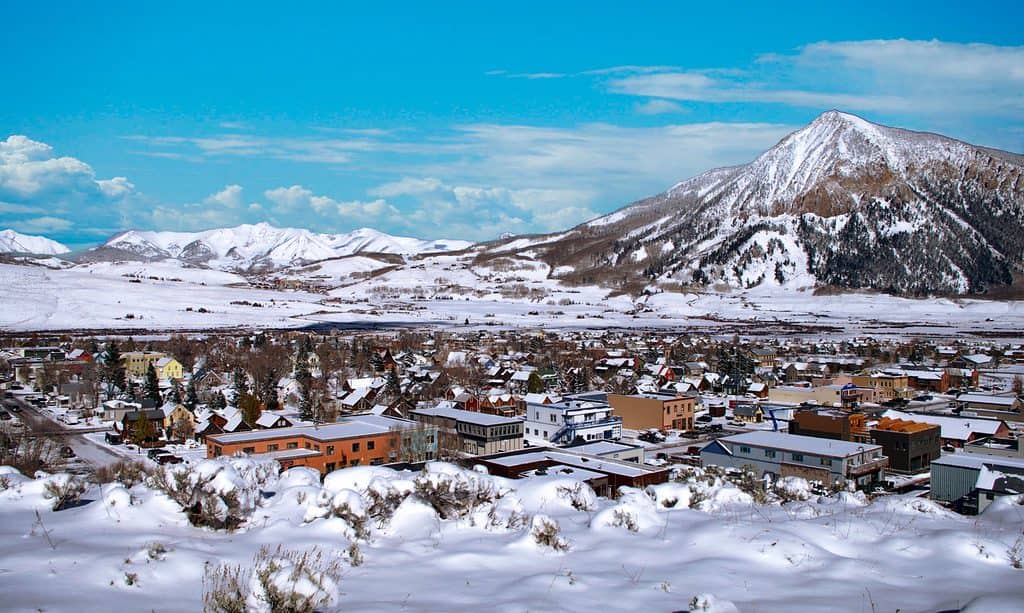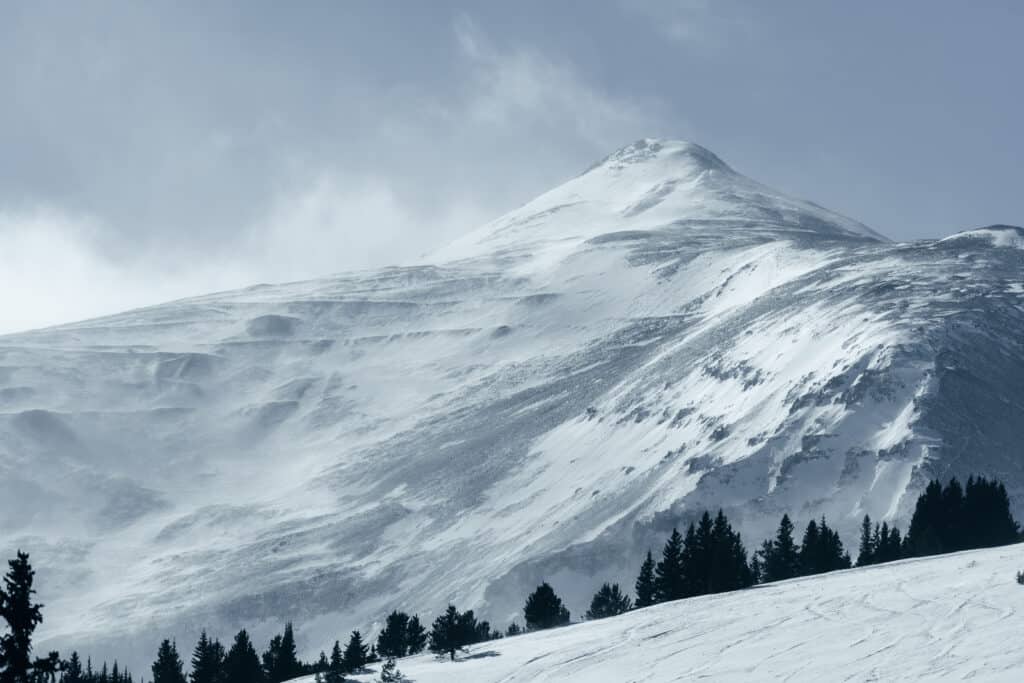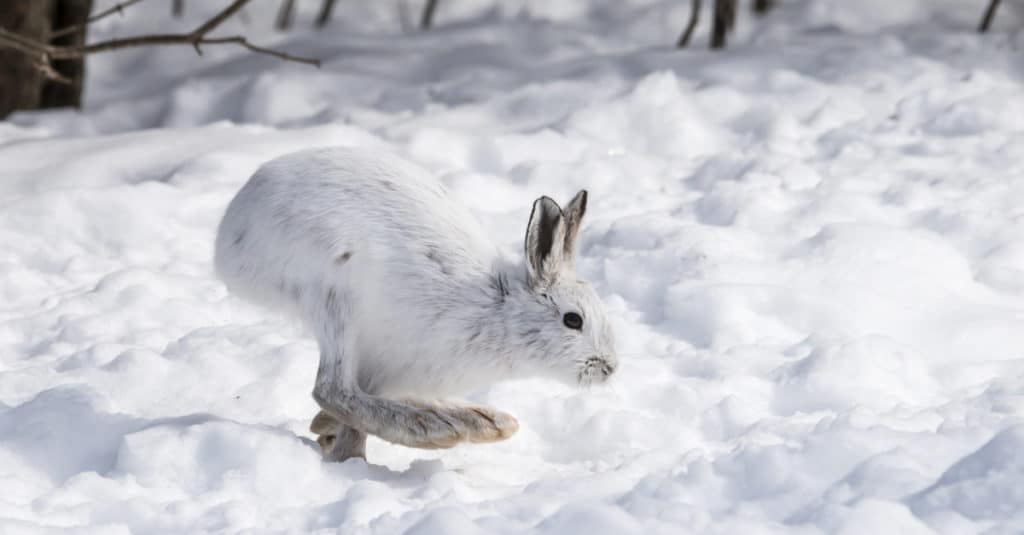Geography of Colorado
The geography of Colorado is incredibly diverse, from rugged mountainous terrain to vast plains and desert lands. This landlocked state has plains and foothills in the north, while the south is composed of arid desert. Most of the state is covered in mountains.
Colorado’s weather is heavily influenced by its mountainous regions, leading to microclimates in certain areas. A regional atmospheric phenomenon known as the Denver Convergence Vorticity Zone (DCVZ) often occurs over the high plains just east of Denver. This strange event results in a “Denver Cyclone”, which can significantly impact weather across much of the state. An example is the so-called “Colorado Low,” which can be affected by air pressure from the nearby Rocky Mountains.
Average January Temperatures in Colorado

In the mountains, the coldest months are typically December and January, with an average temperature of around 19°F.
©iStock.com/stockphoto52
The average January temperatures in Colorado vary greatly depending on the region. Generally, the average high is 45°F, and the low is 18°F.
In the mountains, the coldest months are typically December and January, with an average temperature of around 19°F. Higher elevations in these regions can experience even colder temperatures, often reaching below zero at night.
Along Colorado’s Front Range, which includes Denver and surrounding cities, winter temperatures tend to be milder due to elevation gain from east to west. Average January temperatures here range from 30-40°F during the day, dropping into the teens at night. While ski resorts receive heavy snowfall, many areas along the Front Range see little snowfall during a typical January. This is due to warm daytime temperatures that inhibit snow formation and accumulation.
Coldest January on Record in Colorado
Colorado experienced its coldest January on record in 1989. On January 13th, 1989, the temperature was -56° Fahrenheit in Taylor Park, CO! Temperatures across the state plummeted to below freezing for several days, causing widespread power outages and road closures. Although it was a difficult time for many Coloradans, residents were able to observe the beauty of winter from inside their cozy homes. Colorado’s scenery has never been more breathtaking, from ice-covered trees and snow-topped mountains to frozen lakes and rivers! Photographers captured stunning images of frosty landscapes throughout the state.
Despite these extreme temperatures, there were still plenty of activities to enjoy, such as skiing, snowshoeing, and sledding. Although this particular January was one of the coldest months, it didn’t stop people from appreciating this beautiful state!
Coldest Day Ever in Colorado

On February 1st, 1985, the temperature dropped to -61°F in Maybell, Colorado.
©Tabor Chichakly/Shutterstock.com
The coldest day ever recorded in Colorado occurred on February 1st, 1985. The temperature dropped to -61°F in Maybell, Colorado. This bone-chilling temperature was one of the coldest ever registered in the continental United States. Snowfall was abundant on this particular winter day, and wind chill temperatures were as low as -110°F. Despite these frigid conditions, many hardy Coloradans ventured out into the frozen landscape for outdoor recreational activities such as skiing and snowboarding.
What is the Cause of this Extreme Cold?
The cause of Maybell, Colorado’s extremely cold temperatures can be attributed to the town’s location. The town is in a high-altitude valley surrounded by mountains that trap the cold air and prevent it from escaping. Additionally, few natural barriers block the winds that blow through this area, further amplifying the effects of the frigid temperatures. Furthermore, these winds bring moisture with them, which condenses into snow or ice when it reaches the ground. This results in even colder conditions than normal for this time of year. Finally, due to its remote location, Maybell is rarely subject to urban heat islands or oceanic influences like El Nino. This means that its coldest months remain consistent year after year.
How Wildlife Survive Cold Winters in Colorado
The wild animals of Colorado have developed a variety of strategies to stay warm throughout the coldest months. Migratory birds fly south for warmer temperatures, while some species remain in the area and hunker down for winter. Smaller animals like squirrels store extra food during autumn and use it as a source of energy through the winter. They may also create nests or burrows underground where they can escape direct contact with harsh winds, snow, or ice.
Larger mammals such as deer often take refuge in thickets or near evergreen trees that protect against wind chill factors. Many larger animals also grow additional fur layers during fall, which helps keep them insulated from the coldest temperatures.
Many birds possess physical adaptations that help them survive Colorado’s cold. These include fluffing up their feathers for extra insulation and huddling together to share body heat. They also conserve energy by slowing down their metabolic rate.
Some species of wildlife, such as black bears, enter a hibernation-like state during the winter months. They slow their metabolism and lower their body temperature, allowing them to sleep for around 200 days without consuming food or water. Other animals undergo torpor – a short-term form of hibernation throughout the day, where they become inactive. Other animals, such as garter snakes, bats, marmots, and chipmunks, also undergo a type of hibernation. Pocket gophers remain active all winter but burrow deep below ground, where they are protected from cold temperatures and snowfall.
Whether migrating until spring arrives or adapting physically or behaviorally, each species has their unique way of surviving.
Snowshoe Hare

When winter arrives, its coat changes to white in order to provide camouflage among the snow.
©FotoRequest/Shutterstock.com
The snowshoe hare, native to North America and parts of northern Europe, is well adapted for living in cold climates. During the summer months, its coat is usually a brown color which helps it blend into the environment. When winter arrives, however, its coat changes to white in order to provide camouflage among the snow. This adaptation allows the snowshoe hare to avoid predators and easily find food. The unique ability of adapting coats according to the season has enabled many animals to survive harsh winters for centuries.
Ermine
The ermine, a small mammal of the mustelid family (which includes weasels), is notorious for its white winter coat. The ermine live in the alpine tundra, where their thick fur helps them stay warm during Colorado’s coldest months. But unlike snowshoe hares, whose white fur helps them blend into their snowy environment, ermines use their coats for hunting. Their specific form of camouflage helps them sneak up on unsuspecting prey! They also have sharp claws and powerful jaws, which give them an advantage when it comes to hunting. Despite being so tiny, the ermine has adapted perfectly to survive in one of the colder states in America!
Canada Goose
The Canada goose is one of Colorado’s most noticeable birds during the winter months. While some bird species move south to escape the cold, these hardy birds stay in the state year-round. In fact, if you frequent urban parks in Colorado, then you’re quite familiar with them! They form large flocks that can be seen on golf courses and other green areas around Denver. The sight of them soaring through the sky or grazing is a reminder that wildlife thrives even in frigid seasons.
Junco
The junco is a small, hardy bird that migrates to Colorado from much colder regions further north. These birds are usually grey in color and have the ability to forage for food on or near the ground. During the coldest months, they often hang around bird feeders or in shrubby environments searching for sustenance. Despite their small size and limited resources, these plucky birds make it through even Colorado’s harshest winters.
The photo featured at the top of this post is © iStock.com/RoschetzkyIstockPhoto
Sources
- climate.colostate.edu, Available here: https://climate.colostate.edu/records.html
- usclimatedata.com, Available here: https://www.usclimatedata.com/climate/colorado/united-states/3175
- coloradovirtuallibrary.org, Available here: https://www.coloradovirtuallibrary.org/resource-sharing/state-pubs-blog/how-wildlife-survive-colorado-winters
- cpw.state.co, Available here: https://cpw.state.co.us/learn/Pages/SpeciesProfiles.aspx
Thank you for reading! Have some feedback for us? Contact the AZ Animals editorial team.






